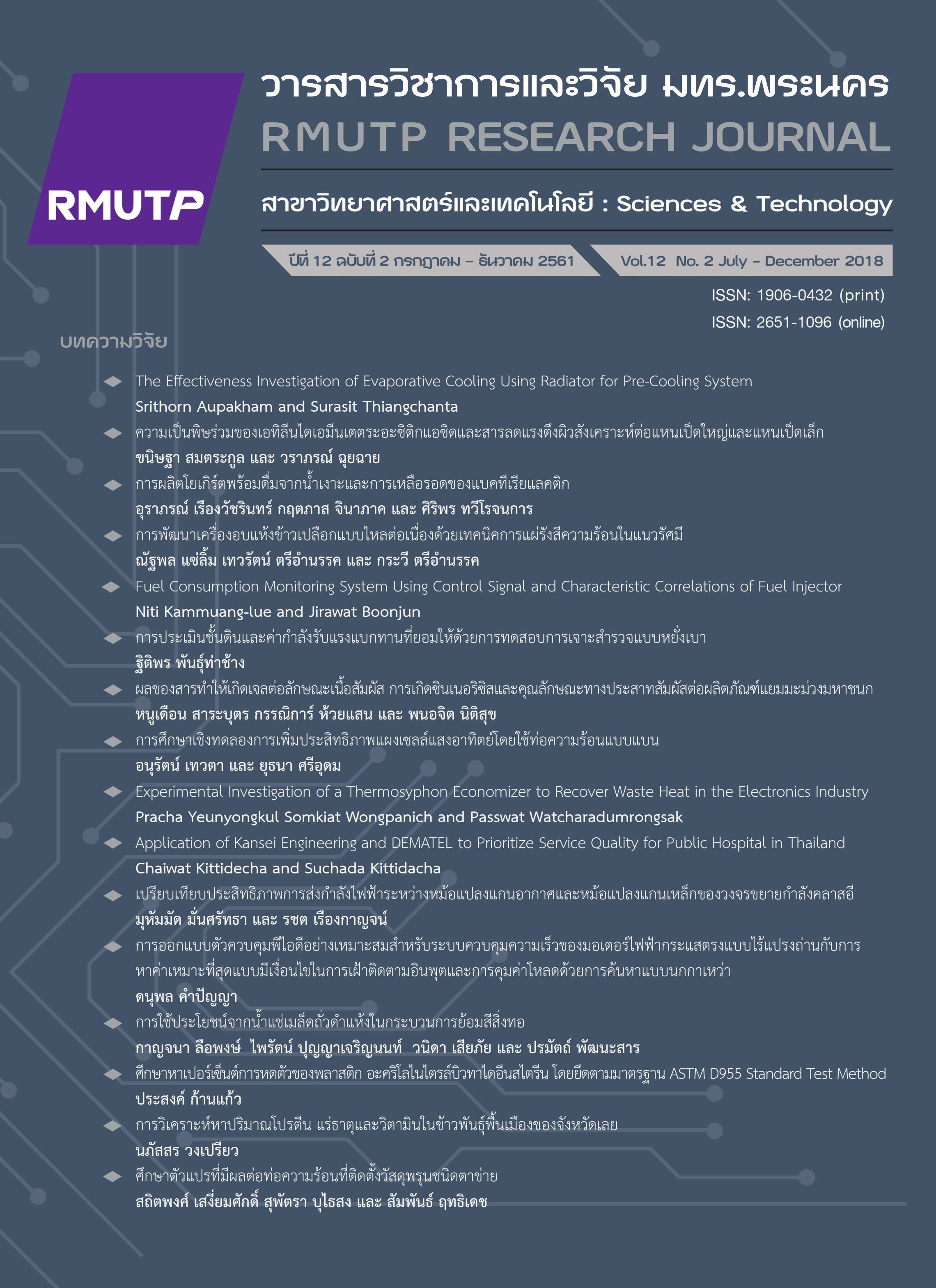Application of Kansei Engineering and DEMATEL to prioritize service quality in Thai government hospital
Main Article Content
Abstract
The health care industry is one of the fast growth industries in Thailand. Thai hospitals have been promoted and set out a strategic policy to be ‘‘Medical Hub of Asia’’ since 2004. In addition, the chief executive officers have determined strategies to improve their service quality because of the global competition. Therefore, service quality which refers to customer perceptions of the service process has been interested and considered. Kansei Engineering is the best tool for translating customer perceptions and emotions to the psychical desire attributes. This study conducted Kansei Engineering and service quality to analyze the relationships between service quality and customer’s emotion and feeling. Furthermore, the decision making trial and evaluation laboratory (DEMATEL) was employed to constructs the cause-effect relationship of criteria which the model can be described the complex causal relationships. The results show that tangible and empathy are the key factors and the government hospital directors should be the first priority for improvement or investment in terms of the development strategy.
Article Details
References
[2] A. Parasuraman, V. Zeithaml, and L. Berry, ‘‘SERVQUAL: a multiple-item scale for measuring consumer perceptions of service quality,’’ Journal of Retailing, vol. 64(1), pp. 12-40, 1988.
[3] M. Nagamachi, ‘‘Kansei Engineering: A powerful ergonomic technology for product development,’’ in Proceeding of International Conference on Affective Human Factors Design, in M.G. Helander, H. M. Khalid and M. P. Tham, eds. London, ASEAN Academic Press, 2001, pp. 9 -14.
[4] M.C. Chen, C.L. Hsu, K.C. Chang and M.C. Chou, ‘‘Applying Kansei engineering to design logistics services - a case of home delivery service,’’ International Journal of Industrial Ergonomics, vol. 48, pp. 46-59, Jul. 2015.
[5] M. Hartono, ‘‘Incorporating service quality tools into Kansei engineering in services: a case study of Indonesian tourists,’’ Procedia Economics and Finance, vol. 4, pp. 201-212, 2012.
[6] C.C. Chenga, C.T. Chena, F.S. Hsua and H.Y. Hub, ‘‘Enhancing service quality improvement strategies of fine-dining restaurants: New insights from integrating a two-phase decision-making model of IPGA and DEMATEL analysis,’’ International Journal of Hospitality Management, vol. 31, pp. 1155– 1166, Dec. 2012.
[7] I.S. Chen, ‘‘A combined MCDM model based on DEMATEL and ANP for the selection of airline service quality improvement criteria: A study based on the Taiwanese airline industry,’’ Journal of Air Transport Management, vol. 57, pp. 7-18, Oct. 2016.
[8] J.I. Shieh, Hs.H. Wub and K.K. Huang, ‘‘A DEMATEL method in identifying key success factors of hospital service quality,’’ Knowledge-Based Systems, vol. 23, pp. 277–282, Apr. 2010.
[9] M.L. Tseng, ‘‘Using the extension of DEMATEL to integrate hotel service quality perceptions into a cause–effect model in uncertainty,’’ Expert Systems with Applications, vol. 36 (5), pp. 9015–9023, Jul. 2009.
[10] H.Y. Hu, S.I. Chiu, C.C. Cheng and T.M. Yen, ‘‘Applying the IPA and DEMATEL models to improve the order-winner criteria: a case study of Taiwan’s network communication equipment manufacturing industry,’’ Expert Systems with Applications, vol. 38 (8), pp. 9674–9683, Aug. 2011.
[11] J. Jassbi, F. Mohamadnejad and H. Nasrollahzadeh, ‘‘A Fuzzy DEMATEL framework for modeling cause and effect relationships of strategy map,’’ Expert Systems with Applications, vol. 38, pp. 5967–5973, May. 2011.
[12] J. Vieira, J.M.A. Osorio, S. Mouta, P. Delgado, A. Portinha, J. F. Meireles and J.A. Santos, ‘‘Kansei engineering as a tool for the design of in-vehicle rubber keypads.’’ Applied Ergonomics, vol. 61, pp. 1-11, May. 2017.
[13] A. Shergian and T. Immawan, ‘‘Design of innovative alarm clock made from bamboo with Kansei engineering,’’ Approach Agriculture and Agricultural Science Procedia, vol. 3, pp. 184 – 188, 2015.
[14] C.C. Hsu, S.C. Fann, M.C. Chuang, ‘‘Relationship between eye fixation patterns and Kansei evaluation of 3D chair forms,’’ Displays, vol. 50, pp. 21–34, Dec. 2017.
[15] N.K. Chuan, A. Sivaji, M.M. Shahimin and N. Saad, ‘‘Kansei engineering for e-commerce sunglasses selection in Malaysia,’’ Procedia - Social and Behavioral Sciences, vol. 97, pp. 707 – 714, Nov. 2013.
[16] Y.H. Hsiao , M.C. Chen and W.C. Liao, ‘‘Logistics service design for cross-border E-commerce using Kansei engineering with text-mining-based online content analysis,’’ Telematics and Informatics, vol. 34, pp. 284-302, Jul. 2017.
[17] Y.J. Chiu, H.C. Chen, G.H. Tzeng and J.Z. Shyu, ‘‘Marketing strategy based on customer behaviour for the LCD-TV,’’ International Journal and Decision Making, vol. 7(2/3), pp. 143–165, Mar. 2006.
[18] H.S. Lee , G.H.Tzeng, W. Yeih, Y.J. Wang and S.C. Yang, ‘‘Revised DEMATEL: resolving the infeasibility of DEMATEL,’’ Applied Mathematical Modelling, vol. 37, pp. 6746–6757, Jul. 2013.
[19] S.Schütte and J.Eklund, ‘‘Design of rocker switches for work-vehicles-an application of Kansei Engineering,’’ Applied Ergonomics, vol. 36, pp. 557-567, Sep. 2005.
[20] Wikipedia. (2018, Jan 10). Emotion classification. [Online]. Available: https://en.wikipedia.org/wiki/Emotion_classification
[21] K. Yousapronpaiboon, and W.C. Johnson, ‘‘A comparison of service quality between private and public hospitals in Thailand,’’ International Journal of Business and Social Science, vol. 4(11), pp.176-184, Sep. 2013.

